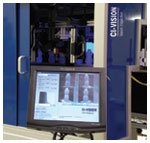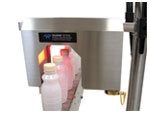
Vision systems and sensor-based systems are both increasing their versatility due to adjustments in functionality.
On many packaging lines, automatic inspection-for functions like verifying labels, checking fill levels, ensuring that closures are on properly-is an important aspect of quality control. There used to be a clear delineation between the two major alternatives: machine vision systems that analyze images taken by cameras, and sensors that deliver a yes/no assessment of a single aspect.
But technology, as it often does, is blurring that distinction. Processing power can make some sensors “smarter,” more capable of making finer distinctions and handling more packaging variations. At the other end, camera-based systems are available in a greater variety of functionalities, meaning that a more limited application can be handled by a lower-level system-at a lower price.
“Not to confuse everybody, but the distinction between tasks that can be done by a sensor, smart camera, or vision system is not sharp,” says Ben Dawson, director of strategic development for Dalsa Corp., a supplier of cameras, smart cameras and machine vision systems.
Cracking the code
A major opportunity to cross the line comes in the form of bar codes. For reading bar codes in various contexts, whether on an individual package or a pallet, laser scanners used to be the norm. But developments like the two-dimensional (2D) bar code, unreadable by conventional laser scanners, are pushing some packagers toward cameras.“One of the largest factors [pushing packagers towards cameras] has been data matrix symbology, the 2D bar code,” says Mark Lampert, business development manager for food and beverage at Banner Engineering. “You cannot look at a data matrix code with a linear bar code reader.”
Using cameras for bar code reading, of either 2D or regular codes, has other advantages. The versatility of a vision system allows it to “search” a label for bar codes, permitting the codes can appear almost anywhere on the label. This enables the system to accommodate different packages with little or no adjustment.
“Historically, with a linear code, you need to either buy a very expensive omni-directional code reader, or you’d have to physically move the bar code, whereas a vision systems doesn't care," Lampert says.
Looking at list
This versatility can extend to other aspects of a label or package. A properly configured vision system can look for a list of things on a label and elsewhere on a package in addition to the bar code. This is because, not only can the camera see more, but the software behind the camera can do more.Scott Stone, marketing manager for CIVision, says some of the vision systems that CIVision markets can store up to 1,000 configurations.
“You can look for ID, you can look for color, you can read product codes [in addition to] bar codes,” Stone says.
In some applications, cameras are performing functions that used to be done by lower-level sensors that use infrared, laser or other means of detection. This enables an inspection system to finesse difficult applications.
Teledyne TapTone is marketing the CapVu, a system that uses a camera to check for missing or misapplied caps. TapTone had been using downward-looking photo-reflective sensors in earlier systems, but those had problems working with “flood-filled” containers, i.e., bottles filled to the very top, at or above the bottom of the cap line. This is because portions of the container, filled with an opaque product, could block the light beam just as a cap would.
“That sensor could be faked out by flood-filled containers, whereas of course the camera sensor isn’t,” says Rick Reardon, a product line manager for Teledyne TapTone. CapVu cameras can handle a variety of closures and, with a slight modification, can also look for missing inkjet or laser codes.

Vision systems perform "simple" functions like cap verification with reliability, especially with challenging containers.
Vision sensors
This trend of vision systems performing functions that had been left to lower-level sensors has been going on for about three years, says Roger Altendorf, business development manager for Balluff Inc. He used the term “vision sensor” to refer to machine-vision systems that operate with lower functionality than usual, like his own company’s Sharpshooter. The differences are performance, speed, and the number of inspection “tools,” or aspects of a package that a system can measure. By operating with reduced functionality, a vision sensor can combine the versatility of a vision system with the lower cost and simpler interface of a sensor.Technology also is closing the gap from the other direction. Processing power also enables sensors to handle more profiles and subtler distinctions in products than before.
Tim Kelley, VP of business development and marketing at sensor vendor Tri-Tronics, says these “smart sensors” are able to handle low-contrast applications, where the differences between light and dark areas are relatively subtle. They are programmable, fast, accurate and robust.
Increased functionality can even help sensors with seemingly mundane aspects such as lighting. Banner’s Lampert described how some sensors can be thrown off by the flickering of fluorescent lighting common to plants, especially if the sensor is looking up at the conveyor.
“A microprocessor-based sensor will have an algorithm that pulses the LED [light-emitting diode] light at a very specific frequency, and looks for that specific frequency coming back,” Lampert says. “It will change that frequency at a periodic rate, so it’s not always looking at that same frequency.” The increased functionality can help with other application aspects such as timing functions and customization, he says.
Improvements in technology and processing power have given users of automatic detection many more options. Judicious use of those options will help make quality control clearer than ever.F&BP
FOR MORE INFORMATION
Balluff Inc.
800-543-8390;www.balluff.com
Banner Engineering
888-373-6767;www.bannerengineering.com
CIVision
630-446-7700;www.civision.com
Dalsa Corp
978-670-2000;www.dalsa.com/mv
Teledyne TapTone
508-563-1000;www.taptone.com
Tri-Tronics
800-237-0946;www.ttco.com
